Mitochondrial Cytochrome bc1 Complex as Validated Drug Target: A Structural Perspective
Abstract
:1. Introduction
1.1. The Essentiality of Respiratory Chain Components in the Mitochondrial Function of Eukaryotic Organisms
1.2. The Electron Transport Chain (ETC)
1.3. Mitochondrial Cytochrome bc1 or Complex III
1.4. Issues to Be Addressed Using Complex III as a Drug Target
2. Natural Compounds Targeting Mitochondrial cyt bc1 Complex
2.1. Complex III as a Target for Natural Compounds
2.2. Classification of cyt bc1 Inhibitors
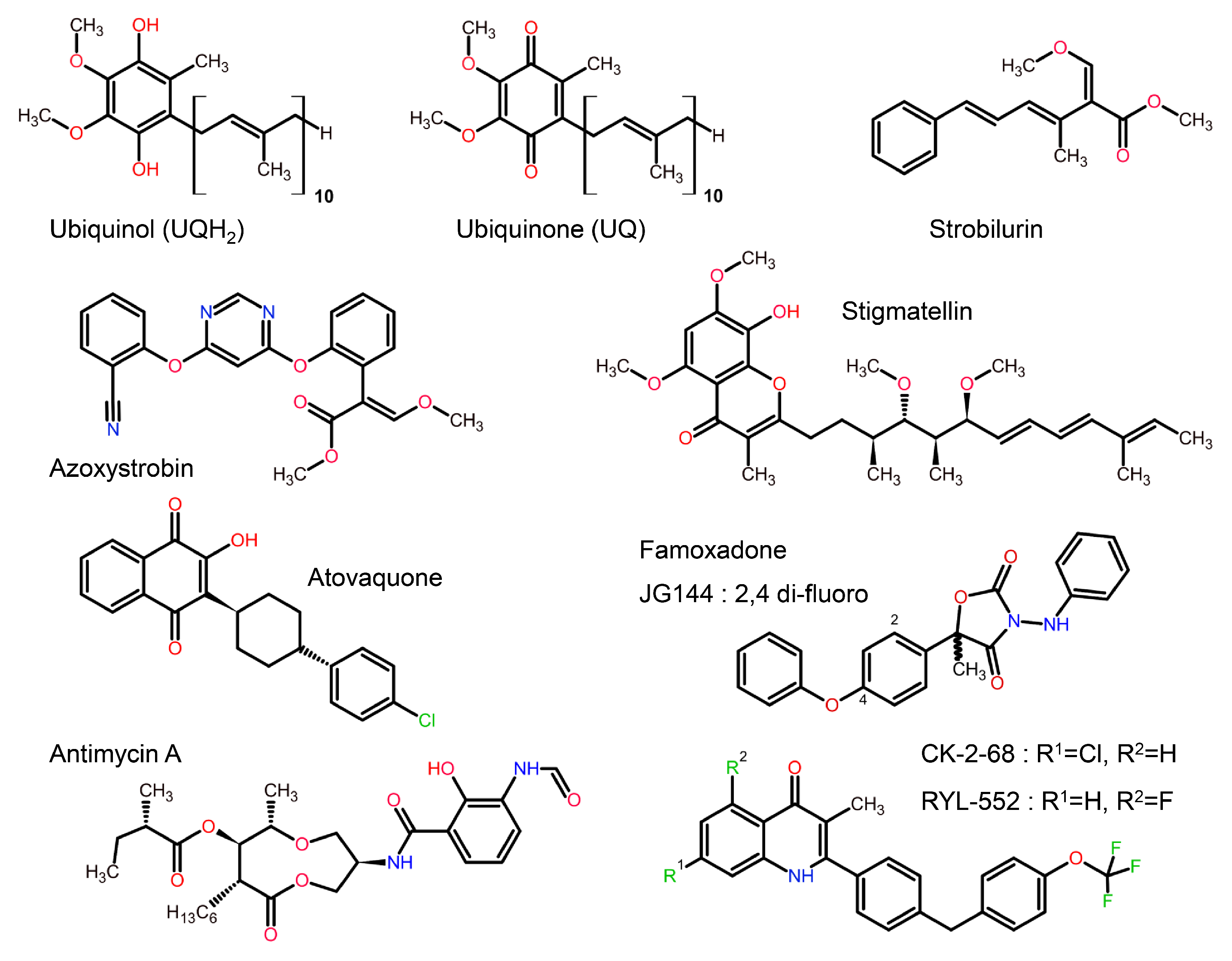
2.3. Implication of ISP-ED Conformational Transition to the Q-Cycle Mechanism
3. Pesticide Development
3.1. Synthetic Fungicides
3.2. Structural Characterization of the Mechanisms of Inhibition
3.3. Understanding the Mechanism of Resistance
3.4. Strategy to Overcome Complex III Resistance
3.4.1. Developing New Classes of Complex III Inhibitors
3.4.2. Targeting Alternate ETC Components
3.4.3. Combinatorial/Alternate Use of Inhibitors
4. Target cyt bc1 of Human and Animal Pathogens
4.1. Medicinal Compounds Targeting Mitochondrial cyt bc1 of Human, Malaria, and Fungal Pathogens
4.2. Structural Studies of Selective cyt bc1 Inhibitors
4.3. Use of Bacterial and Mitochondrial cyt bc1 to Search for Selective QoIs
5. Challenges in Drug Design and Future Developments
Author Contributions
Funding
Institutional Review Board Statement
Informed Consent Statement
Data Availability Statement
Conflicts of Interest
Abbreviations
| Cyt1 | yeast cyt c1; |
| cyt c1 | cytochrome c1; |
| cyt b | cytochrome b; |
| cyt bc1 | cytochrome bc1 or complex III; |
| Btbc1 | Bos Taurus or bovine cyt bc1 complex; |
| Pfbc1 | Plasmodium falciparum cyt bc1 complex; |
| Rsbc1 | Rhodobacter sphaeroides cyt bc1 complex; |
| Scbc1 | Saccharomyces cerevisiae cyt bc1 complex; |
| ET | electron transfer; |
| ETC | electron transport chain; |
| Fe2S2 | iron-sulfur cluster; |
| HTS | high throughput screening; |
| ISP | Rieske iron-sulfur protein; |
| ISP-ED | extrinsic domain of the Rieske iron-sulfur protein; |
| IM | mitochondrial inner membrane; |
| IMS | mitochondrial intermembrane space; |
| OM | mitochondrial outer membrane; |
| PMF | proton motive force; |
| QN/QI | ubiquinone reduction site; |
| QP/QO | ubiquinol oxidation site; |
| QoI | Qo site inhibitor; |
| TIM | translocase of the inner mitochondrial membrane; |
| TM | transmembrane; |
| UQ | ubiquinone; |
| UQH2 | ubiquinol. |
References
- Letts, J.A.; Sazanov, L.A. Clarifying the supercomplex: The higher-order organization of the mitochondrial electron transport chain. Nat. Struct. Mol. Biol. 2017, 24, 800–808. [Google Scholar] [CrossRef]
- Sarewicz, M.; Osyczka, A. Electronic connection between the quinone and cytochrome C redox pools and its role in regulation of mitochondrial electron transport and redox signaling. Physiol. Rev. 2015, 95, 219–243. [Google Scholar] [CrossRef]
- Esser, L.; Zhou, F.; Yu, C.A.; Xia, D. Structure-funciton studies of the cytochrome bc1 compex of anoxygenic photosynthetic purple bacteria. In Cytochrome Complexes: Evolution, Structures, Energy Transduction, and Signaling; Cramer, W.A., Kallas, T., Eds.; Advances in Photosynthesis and Respiration; Springer Science: Berlin/Heidelberg, Germany, 2016; Chapter 10. [Google Scholar]
- Xia, D.; Esser, L.; Yu, L.; Yu, C.A. Structural basis for the mechanism of electron bifurcation at the quinol oxidation site of the cytochrome bc1 complex. Photosynth. Res. 2007, 92, 17–34. [Google Scholar] [CrossRef]
- Berry, E.A.; Guergova-Kuras, M.; Huang, L.; Crofts, A.R. Structure and Function of Cytochrome bc1 Complex. Annu. Rev. Biochem. 2002, 69, 1005–1075. [Google Scholar] [CrossRef]
- Schmidt, O.; Pfanner, N.; Meisinger, C. Mitochondrial protein import: From proteomics to functional mechanisms. Nat. Rev. Mol. Cell Biol. 2010, 11, 655–667. [Google Scholar] [CrossRef]
- Gray, L.R.; Tompkins, S.C.; Taylor, E.B. Regulation of pyruvate metabolism and human disease. Cell. Mol. Life Sci. 2014, 71, 2577–2604. [Google Scholar] [CrossRef]
- Rossi, A.; Pizzo, P.; Filadi, R. Calcium, mitochondria and cell metabolism: A functional triangle in bioenergetics. Biochim. Biophys. Acta Mol. Cell Res. 2019, 1866, 1068–1078. [Google Scholar] [CrossRef]
- Ward, D.M.; Cloonan, S.M. Mitochondrial Iron in Human Health and Disease. Annu. Rev. Physiol. 2019, 81, 453–482. [Google Scholar] [CrossRef] [PubMed]
- Horvath, S.E.; Daum, G. Lipids of mitochondria. Prog. Lipid Res. 2013, 52, 590–614. [Google Scholar] [CrossRef] [PubMed]
- Yin, M.; O’Neill, L.A.J. The role of the electron transport chain in immunity. FASEB J. 2021, 35, e21974. [Google Scholar] [CrossRef] [PubMed]
- Nunnari, J.; Suomalainen, A. Mitochondria: In sickness and in health. Cell 2012, 148, 1145–1159. [Google Scholar] [CrossRef]
- Koonin, E.V. The origin and early evolution of eukaryotes in the light of phylogenomics. Genome Biol. 2010, 11, 209. [Google Scholar] [CrossRef]
- Kutik, S.; Stroud, D.A.; Wiedemann, N.; Pfanner, N. Evolution of mitochondrial protein biogenesis. Biochim. Biophys. Acta 2009, 1790, 409–415. [Google Scholar] [CrossRef]
- Ott, M.; Herrmann, J.M. Co-translational membrane insertion of mitochondrially encoded proteins. Biochim. Biophys. Acta 2010, 1803, 767–775. [Google Scholar] [CrossRef]
- Hashimoto, Y.; Niikura, T.; Tajima, H.; Yasukawa, T.; Sudo, H.; Ito, Y.; Kita, Y.; Kawasumi, M.; Kouyama, K.; Doyu, M.; et al. A rescue factor abolishing neuronal cell death by a wide spectrum of familial Alzheimer’s disease genes and A beta. Proc. Natl. Acad. Sci. USA 2001, 98, 6336–6341. [Google Scholar] [CrossRef]
- Mathur, V.; Wakeman, K.C.; Keeling, P.J. Parallel functional reduction in the mitochondria of apicomplexan parasites. Curr. Biol. 2021, 31, 2920–2928.e4. [Google Scholar] [CrossRef] [PubMed]
- Berna, L.; Rego, N.; Francia, M.E. The Elusive Mitochondrial Genomes of Apicomplexa: Where Are We Now? Front. Microbiol. 2021, 12, 751775. [Google Scholar] [CrossRef] [PubMed]
- van Dooren, G.G.; Stimmler, L.M.; McFadden, G.I. Metabolic maps and functions of the Plasmodium mitochondrion. Fems Microbiol. Rev. 2006, 30, 596–630. [Google Scholar] [CrossRef] [PubMed]
- Javadov, S.; Jang, S.; Chapa-Dubocq, X.R.; Khuchua, Z.; Camara, A.K. Mitochondrial respiratory supercomplexes in mammalian cells: Structural versus functional role. J. Mol. Med. 2021, 99, 57–73. [Google Scholar] [CrossRef] [PubMed]
- McDonald, A.E.; Vanlerberghe, G.C. Branched mitochondrial electron transport in the animalia: Presence of alternative oxidase in several animal phyla. IUBMB Life 2004, 56, 333–341. [Google Scholar] [CrossRef] [PubMed]
- Trumpower, B.L. The protonmotive Q cycle. Energy transduction by coupling of proton translocation to electron transfer by the cytochrome bc1 complex. J. Biol. Chem. 1990, 265, 11409–11412. [Google Scholar] [CrossRef]
- Fernandez-Ortuno, D.; Tores, J.A.; de Vicente, A.; Perez-Garcia, A. The Qol fungicides, the rise and fall of a successful class of agricultural fungicides. In Fungicides; Carisse, O., Ed.; InTech: London, UK, 2010; Chapter 10; pp. 203–220. [Google Scholar]
- Srivastava, I.K.; Morrisey, J.M.; Darrouzet, E.; Daldal, F.; Vaidya, A.B. Resistance mutations reveal the atovaquone-binding domain of cytochrome b in malaria parasites. Mol. Microbiol. 1999, 33, 704–711. [Google Scholar] [CrossRef]
- Steinfeld, U.; Sierotzki, H.; Parisi, S.; Poirey, S.; Gisi, U. Sensitivity of mitochondrial respiration to different inhibitors in Venturia inaequalis. Pest Manag. Sci. 2001, 57, 787–796. [Google Scholar] [CrossRef] [PubMed]
- Vincelli, P.; Dixon, E. Resistance to QoI (Strobilurin-like) Fungicides in Isolates of Pyricularia grisea from Perennial Ryegrass. Plant Dis. 2002, 86, 235–240. [Google Scholar] [CrossRef] [PubMed]
- Goodman, C.D.; Buchanan, H.D.; McFadden, G.I. Is the Mitochondrion a Good Malaria Drug Target? Trends Parasitol. 2017, 33, 185–193. [Google Scholar] [CrossRef]
- Palmer, G.; Horgan, D.J.; Tisdale, H.; Singer, T.P.; Beinert, H. Studies on Respiratory Chain-Linked Reduced Nicotinamide Adenine Dinucleotide Dehydrogenase: 14. Location of Sites of Inhibition of Rotenone Barbiturates and Piericidin by Means of Electron Paramagnetic Resonance Spectroscopy. J. Biol. Chem. 1968, 243, 844–847. [Google Scholar] [CrossRef]
- Degli Esposti, M.; Ghelli, A.; Crimi, M.; Estornell, E.; Fato, R.; Lenaz, G. Complex I and complex III of mitochondria have common inhibitors acting as ubiquinone antagonists. Biochem. Biophys. Res. Commun. 1993, 190, 1090–1096. [Google Scholar] [CrossRef] [PubMed]
- von Jagow, G.; Ohnishi, T. The chromone inhibitor stigmatellin—Binding to the ubiquinol oxidation center at the C-side of the mitochondrial membrane. FEBS Lett. 1985, 185, 311–315. [Google Scholar] [CrossRef]
- Becker, W.F.; von Jagow, G.; Anke, T.; Steglich, W. Oudemansin, strobilurin A, strobilurin B and myxothiazol: New inhibitors of the bc1 segment of the respiratory chain with an E-beta-methoxyacrylate system as common structural element. FEBS Lett. 1981, 132, 329–333. [Google Scholar] [CrossRef]
- Anke, T.; Oberwinkler, F.; Steglich, W.; Schramm, G. The strobilurins--new antifungal antibiotics from the basidiomycete Strobilurus tenacellus. J. Antibiot. 1977, 30, 806–810. [Google Scholar] [CrossRef]
- Sauter, H.; Steglich, W.; Anke, T. Strobilurins: Evolution of a new class of active substances. Angew. Chem. Int. Ed. 1999, 38, 1329–1349. [Google Scholar] [CrossRef]
- Thierbach, G.; Reichenbach, H. Myxothiazol, a new inhibitor of the cytochrome b-c1 segment of th respiratory chain. Biochim. Biophys. Acta 1981, 638, 282–289. [Google Scholar] [CrossRef]
- Potter, V.R.; Reif, A.E. Inhibition of an Electron Transport Component by Antimycin-A. J. Biol. Chem. 1952, 194, 287–297. [Google Scholar] [CrossRef]
- Ramachandran, S.; Gottlieb, D. Mode of Action of Antibiotics.2. Specificity of Action of Antimycin a and Ascosin. Biochim. Biophys. Acta 1961, 53, 396–402. [Google Scholar] [CrossRef]
- Goertz, A.; Genet, J.L. CropLife International A.I.S.B.L., Belgium. 2023. Available online: https://www.frac.info (accessed on 5 December 2023).
- Hatefi, Y. The mitochondrial electron transport and oxidative phosphorylation system. Annu. Rev. Biochem. 1985, 54, 1015–1069. [Google Scholar] [CrossRef] [PubMed]
- von Jagow, G.; Ljungdahl, P.O.; Graf, P.; Ohnishi, T.; Trumpower, B.L. An inhibitor of mitochondrial respiration which binds to cytochrome b and displaces quinone from the iron-sulfur protein of the cytochrome bc1 complex. J. Biol. Chem. 1984, 259, 6318–6326. [Google Scholar] [CrossRef] [PubMed]
- Wikstrom, M.K.; Berden, J.A. Oxidoreduction of Cytochrome-B in Presence of Antimycin. Biochim. Biophys. Acta 1972, 283, 403–420. [Google Scholar] [CrossRef]
- Chance, B.; Wilson, D.F.; Dutton, P.L.; Erecinska, M. Energy-coupling mechanisms in mitochondria: Kinetic, spectroscopic, and thermodynamic properties of an energy-transducing form of cytochrome b. Proc. Natl. Acad. Sci. USA 1970, 66, 1175–1182. [Google Scholar] [CrossRef]
- Xia, D.; Yu, C.A.; Kim, H.; Xia, J.Z.; Kachurin, A.M.; Zhang, L.; Yu, L.; Deisenhofer, J. Crystal structure of the cytochrome bc1 complex from bovine heart mitochondria. Science 1997, 277, 60–66. [Google Scholar] [CrossRef]
- Zhang, Z.; Huang, L.; Shulmeister, V.M.; Chi, Y.I.; Kim, K.K.; Hung, L.W.; Crofts, A.R.; Berry, E.A.; Kim, S.H. Electron transfer by domain movement in cytochrome bc1. Nature 1998, 392, 677–684. [Google Scholar] [CrossRef]
- Iwata, S.; Lee, J.W.; Okada, K.; Lee, J.K.; Iwata, M.; Rasmussen, B.; Link, T.A.; Ramaswamy, S.; Jap, B.K. Complete structure of the 11-subunit bovine mitochondrial cytochrome bc1 complex. Science 1998, 281, 64–71. [Google Scholar] [CrossRef]
- Hunte, C.; Koepke, J.; Lange, C.; Rossmanith, T.; Michel, H. Structure at 2.3 A resolution of the cytochrome bc(1) complex from the yeast Saccharomyces cerevisiae co-crystallized with an antibody Fv fragment. Structure 2000, 15, 669–684. [Google Scholar] [CrossRef] [PubMed]
- Capper, M.J.; O’Neill, P.M.; Fisher, N.; Strange, R.W.; Moss, D.; Ward, S.A.; Berry, N.G.; Lawrenson, A.S.; Hasnain, S.S.; Biagini, G.A.; et al. Antimalarial 4(1H)-pyridones bind to the Q(i) site of cytochrome bc(1). Proc. Natl. Acad. Sci. USA 2015, 112, 755–760. [Google Scholar] [CrossRef]
- Hong, W.D.; Leung, S.C.; Amporndanai, K.; Davies, J.; Priestley, R.S.; Nixon, G.L.; Berry, N.G.; Hasnain, S.S.; Antonyuk, S.; Ward, S.A.; et al. Potent Antimalarial 2-Pyrazolyl Quinolone bc(1) (Q(i)) Inhibitors with Improved Drug-like Properties. ACS Med. Chem. Lett. 2018, 9, 1205–1210. [Google Scholar] [CrossRef] [PubMed]
- Crystal Structure of Bovine Cytochrome bc1 in Complex with Quinolone Inhibitor RKA066; the WorldWide Protein Data Bank (wwPDB): USA. 2021. Available online: https://www.wwpdb.org/pdb?id=pdb_00006zfu (accessed on 5 December 2023).
- Berry, E.A.; Huang, L.S.; Lee, D.W.; Daldal, F.; Nagai, K.; Minagawa, N. Ascochlorin is a novel, specific inhibitor of the mitochondrial cytochrome bc(1) complex. Bba-Bioenerg. 2010, 1797, 360–370. [Google Scholar] [CrossRef] [PubMed]
- Esser, L.; Quinn, B.; Li, Y.; Zhang, M.; Elberry, M.; Yu, L.; Yu, C.A.; Xia, D. Crystallographic studies of quinol oxidation site inhibitors: A modified classification of inhibitors for the cytochrome bc1 complex. J. Mol. Biol. 2004, 341, 281–302. [Google Scholar] [CrossRef]
- Gao, X.; Wen, X.; Yu, C.; Esser, L.; Tsao, S.; Quinn, B.; Zhang, L.; Yu, L.; Xia, D. The crystal structure of mitochondrial cytochrome bc1 in complex with famoxadone: The role of aromatic-aromatic interaction in inhibition. Biochemistry 2002, 41, 11692–11702. [Google Scholar] [CrossRef]
- Winter, R.; Kelly, J.X.; Smilkstein, M.J.; Hinrichs, D.; Koop, D.R.; Riscoe, M.K. Optimization of endochin-like quinolones for antimalarial activity. Exp. Parasitol. 2011, 127, 545–551. [Google Scholar] [CrossRef]
- Brandt, U. Bifurcated ubihydroquinone oxidation in the cytochrome bc1 complex by proton-gated charge transfer. FEBS Lett. 1996, 387, 1–6. [Google Scholar] [CrossRef]
- Brandt, U.; von Jagow, G. Analysis of inhibitor binding to the mitochondrial cytochrome c reductase by fluorescence quench titration. Eur. J. Biochem. 1991, 195, 163–170. [Google Scholar] [CrossRef]
- Link, T.A. The role of the ‘Rieske’ iron sulfur protein in the hydroquinone oxidation (Qp) site of the cytochrome bc1 complex—The ‘proton-gated affinity change’ machanism. FEBS Lett. 1997, 412, 257–264. [Google Scholar] [CrossRef]
- Junemann, S.; Heathcote, P.; Rich, P.R. On the mechanism of quinol oxidation in the bc1 complex. J. Biol. Chem. 1998, 273, 21603–21607. [Google Scholar] [CrossRef]
- Ding, H.; Robertson, D.E.; Daldal, F.; Dutton, P.L. Cytochrome bc1 complex [2Fe-2S] cluster and its interaction with ubiquinone and ubihydroquinone at the Qo site: A double-occupancy Qo site model. Biochemistry 1992, 31, 3144–3158. [Google Scholar] [CrossRef] [PubMed]
- Esser, L.; Gong, X.; Yang, S.; Yu, L.; Yu, C.A.; Xia, D. Surface-modulated motion switch: Capture and release of iron-sulfur protein in the cytochrome bc1 complex. Proc. Natl. Acad. Sci. USA 2006, 103, 13045–13050. [Google Scholar] [CrossRef] [PubMed]
- Esser, L.; Zhou, F.; Yu, C.A.; Xia, D. Crystal structure of bacterial cytochrome bc(1) in complex with azoxystrobin reveals a conformational switch of the Rieske iron-sulfur protein subunit. J. Biol. Chem. 2019, 294, 12007–12019. [Google Scholar] [CrossRef] [PubMed]
- Luo, B.; Ning, Y.L.; Rao, B.Q. Comprehensive Overview of beta-Methoxyacrylate Derivatives as Cytochrome bc(1) Inhibitors for Novel Pesticide Discovery. J. Agric. Food Chem. 2022, 70, 15615–15630. [Google Scholar] [CrossRef] [PubMed]
- Jordan, D.B.; Kranis, K.T.; Picollelli, M.A.; Schwartz, R.S.; Sternberg, J.A.; Sun, K.M. Famoxadone and oxazolidinones: Potent inhibitors of cytochrome bc1. Biochem. Soc. Trans. 1999, 27, 577–580. [Google Scholar] [CrossRef] [PubMed]
- Sternberg, J.A.; Geffken, D.; Adams, J.B., Jr.; Postages, R.; Sternberg, C.G.; Campbell, C.L.; Moberg, W.K. Famoxadone: The discovery and optimisation of a new agricultural fungicide. Pest. Manag. Sci. 2001, 57, 143–152. [Google Scholar] [CrossRef] [PubMed]
- Esser, L.; Zhou, F.; Zhou, Y.; Xiao, Y.; Tang, W.K.; Yu, C.A.; Qin, Z.; Xia, D. Hydrogen Bonding to the Substrate Is Not Required for Rieske Iron-Sulfur Protein Docking to the Quinol Oxidation Site of Complex III. J. Biol. Chem. 2016, 291, 25019–25031. [Google Scholar] [CrossRef] [PubMed]
- Cytochrome BC1 Complex from Chicken with Azoxystrobin Bound; the WorldWide Protein Data Bank (wwPDB): USA. 2010. Available online: https://www.wwpdb.org/pdb?id=pdb_00003l71 (accessed on 5 December 2023).
- Cytochrome BC1 Complex from Chicken with Famoxadone Bound; the WorldWide Protein Data Bank (wwPDB): USA. 2010. Available online: https://www.wwpdb.org/pdb?id=pdb_00003l74 (accessed on 5 December 2023).
- Birth, D.; Kao, W.C.; Hunte, C. Structural analysis of atovaquone-inhibited cytochrome bc1 complex reveals the molecular basis of antimalarial drug action. Nat. Commun. 2014, 5, 4029. [Google Scholar] [CrossRef]
- Gisi, U.; Sierotzki, H.; Cook, A.; McCaffery, A. Mechanisms influencing the evolution of resistance to Qo inhibitor fungicides. Pest. Manag. Sci. 2002, 58, 859–867. [Google Scholar] [CrossRef] [PubMed]
- Saccone, C.; De Giorgi, C.; Gissi, C.; Pesole, G.; Reyes, A. Evolutionary genomics in Metazoa: The mitochondrial DNA as a model system. Gene 1999, 238, 195–209. [Google Scholar] [CrossRef] [PubMed]
- Genet, J.L.; Jaworska, G.; Deparis, F. Effect of dose rate and mixtures of fungicides on selection for QoI resistance in populations of Plasmopara viticola. Pest. Manag. Sci. 2006, 62, 188–194. [Google Scholar] [CrossRef] [PubMed]
- Esposti, M.D.; Ghelli, A.; Butler, G.; Roberti, M.; Mustich, A.; Cantatore, P. The Cytochrome-B of the Sea-Urchin Paracentrotus-Lividus Is Naturally Resistant to Myxothiazol and Mucidin. FEBS Lett. 1990, 263, 245–247. [Google Scholar] [CrossRef] [PubMed]
- Matsuzaki, Y.; Yoshimoto, Y.; Arimori, S.; Kiguchi, S.; Harada, T.; Iwahashi, F. Discovery of metyltetraprole: Identification of tetrazolinone pharmacophore to overcome QoI resistance. Bioorg. Med. Chem. 2020, 28, 115211. [Google Scholar] [CrossRef]
- Esser, L.; Yu, C.A.; Xia, D. Structural Basis of Resistance to Anti-Cytochrome bc1 Complex Inhibitors: Implication for Drug Improvement. Curr. Pharm. Des. 2014, 20, 704–724. [Google Scholar] [CrossRef]
- Nixon, G.L.; Pidathala, C.; Shone, A.E.; Antoine, T.; Fisher, N.; O’Neill, P.M.; Ward, S.A.; Biagini, G.A. Targeting the mitochondrial electron transport chain of Plasmodium falciparum: New strategies towards the development of improved antimalarials for the elimination era. Future Med. Chem. 2013, 5, 1573–1591. [Google Scholar] [CrossRef] [PubMed]
- Hughes, T.R. Yeast and drug discovery. Funct. Integr. Genom. 2002, 2, 199–211. [Google Scholar] [CrossRef]
- Rotsaert, F.A.; Ding, M.G.; Trumpower, B.L. Differential efficacy of inhibition of mitochondrial and bacterial cytochrome bc(1) complexes by center N inhibitors antimycin, ilicicolin H and funiculosin. Biochim. Biophys. Acta 2008, 1777, 211–219. [Google Scholar] [CrossRef]
- Gutierrez-Cirlos, E.B.; Merbitz-Zahradnik, T.; Trumpower, B.L. Inhibition of the Yeast Cytochrome bc1 Complex by Ilicicolin H, a Novel Inhibitor That Acts at the Qn Site of teh bc 1 Complex. J. Biol. Chem. 2004, 279, 8708–8714. [Google Scholar] [CrossRef]
- Song, Z.; Iorga, B.I.; Mounkoro, P.; Fisher, N.; Meunier, B. The antimalarial compound ELQ-400 is an unusual inhibitor of the bc(1) complex, targeting both Q(o) and Q(i) sites. FEBS Lett. 2018, 592, 1346–1356. [Google Scholar] [CrossRef]
- McConnell, E.V.; Bruzual, I.; Pou, S.; Winter, R.; Dodean, R.A.; Smilkstein, M.J.; Krollenbrock, A.; Nilsen, A.; Zakharov, L.N.; Riscoe, M.K.; et al. Targeted Structure-Activity Analysis of Endochin-like Quinolones Reveals Potent Qi and Qo Site Inhibitors of Toxoplasma gondii and Plasmodium falciparum Cytochrome bc(1) and Identifies ELQ-400 as a Remarkably Effective Compound against Acute Experimental Toxoplasmosis. ACS Infect. Dis. 2018, 4, 1574–1584. [Google Scholar] [CrossRef] [PubMed]
- Stickles, A.M.; Smilkstein, M.J.; Morrisey, J.M.; Li, Y.; Forquer, I.P.; Kelly, J.X.; Pou, S.; Winter, R.W.; Nilsen, A.; Vaidya, A.B.; et al. Atovaquone and ELQ-300 Combination Therapy as a Novel Dual-Site Cytochrome bc1 Inhibition Strategy for Malaria. Antimicrob. Agents Chemother. 2016, 60, 4853–4859. [Google Scholar] [CrossRef] [PubMed]
- Miley, G.P.; Pou, S.; Winter, R.; Nilsen, A.; Li, Y.; Kelly, J.X.; Stickles, A.M.; Mather, M.W.; Forquer, I.P.; Pershing, A.M.; et al. ELQ-300 prodrugs for enhanced delivery and single-dose cure of malaria. Antimicrob. Agents Chemother. 2015, 59, 5555–5560. [Google Scholar] [CrossRef] [PubMed]
- Stickles, A.M.; de Almeida, M.J.; Morrisey, J.M.; Sheridan, K.A.; Forquer, I.P.; Nilsen, A.; Winter, R.W.; Burrows, J.N.; Fidock, D.A.; Vaidya, A.B.; et al. Subtle changes in endochin-like quinolone structure alter the site of inhibition within the cytochrome bc1 complex of Plasmodium falciparum. Antimicrob. Agents Chemother. 2015, 59, 1977–1982. [Google Scholar] [CrossRef] [PubMed]
- Esser, L.; Zhou, F.; Zeher, A.; Wu, W.; Huang, R.; Yu, C.A.; Lane, K.D.; Wellems, T.E.; Xia, D. Structure of complex III with bound antimalarial agent CK-2-68 provides insights into selective inhibition of Plasmodium cytochrome bc(1) complexes. J. Biol. Chem. 2023, 299, 104860. [Google Scholar] [CrossRef] [PubMed]
- Amporndanai, K.; Pinthong, N.; O’Neill, P.M.; Hong, D.W.; Amewu, R.K.; Pidathala, C.; Berry, N.G.; Leung, S.C.; Ward, S.A.; Biagini, G.; et al. Targeting the ubiquinol-reduction (Qi) site of the mitochondrial cytochrome bc1 complex for the development of next generation quinolone antimalarials. Biology 2022, 11, 1109. [Google Scholar] [CrossRef]
- Gao, X.; Wen, X.; Esser, L.; Yu, L.; Yu, C.A.; Xia, D. Structural basis for the quinone reduction in bc1 complex: A comparative analysis of crystal structures of mitochondrial cytochrome bc1 with bound substrate and inhibitors. Biochemistry 2003, 42, 9067–9080. [Google Scholar] [CrossRef] [PubMed]
- Biagini, G.A.; Viriyavejakul, P.; O’Neill, P.M.; Bray, P.G.; Ward, S.A. Functional characterization and target validation of alternative complex I of Plasmodium falciparum mitochondria. Antimicrob. Agents Chemother. 2006, 50, 1841–1851. [Google Scholar] [CrossRef]
- Ke, H.; Ganesan, S.M.; Dass, S.; Morrisey, J.M.; Pou, S.; Nilsen, A.; Riscoe, M.K.; Mather, M.W.; Vaidya, A.B. Mitochondrial type II NADH dehydrogenase of Plasmodium falciparum (PfNDH2) is dispensable in the asexual blood stages. PLoS ONE 2019, 14, e0214023. [Google Scholar] [CrossRef]
- Boysen, K.E.; Matuschewski, K. Arrested oocyst maturation in Plasmodium parasites lacking type II NADH:ubiquinone dehydrogenase. J. Biol. Chem. 2011, 286, 32661–32671. [Google Scholar] [CrossRef]
- Yang, Y.; Yu, Y.; Li, X.; Li, J.; Wu, Y.; Yu, J.; Ge, J.; Huang, Z.; Jiang, L.; Rao, Y.; et al. Target Elucidation by Cocrystal Structures of NADH-Ubiquinone Oxidoreductase of Plasmodium falciparum (PfNDH2) with Small Molecule To Eliminate Drug-Resistant Malaria. J. Med. Chem. 2017, 60, 1994–2005. [Google Scholar] [CrossRef]
- Biagini, G.A.; Fisher, N.; Shone, A.E.; Mubaraki, M.A.; Srivastava, A.; Hill, A.; Antoine, T.; Warman, A.J.; Davies, J.; Pidathala, C.; et al. Generation of quinolone antimalarials targeting the Plasmodium falciparum mitochondrial respiratory chain for the treatment and prophylaxis of malaria. Proc. Natl. Acad. Sci. USA 2012, 109, 8298–8303. [Google Scholar] [CrossRef]
- Lane, K.D.; Mu, J.; Lu, J.; Windle, S.T.; Liu, A.; Sun, P.D.; Wellems, T.E. Selection of Plasmodium falciparum cytochrome B mutants by putative PfNDH2 inhibitors. Proc. Natl. Acad. Sci. USA 2018, 115, 6285–6290. [Google Scholar] [CrossRef]
- Painter, H.J.; Morrisey, J.M.; Mather, M.W.; Vaidya, A.B. Specific role of mitochondrial electron transport in blood-stage Plasmodium falciparum. Nature 2007, 446, 88–91. [Google Scholar] [CrossRef]
- McKeage, K.; Scott, L. Atovaquone/proguanil: A review of its use for the prophylaxis of Plasmodium falciparum malaria. Drugs 2003, 63, 597–623. [Google Scholar] [CrossRef] [PubMed]
- Gullino, M.L.; Leroux, P.; Smith, C.M. Uses and challenges of novel compounds for plant disease control. Crop Prot. 2000, 19, 1–11. [Google Scholar] [CrossRef]
- Ahn, J.W.; Woo, S.H.; Lee, C.O.; Cho, K.Y.; Kim, B.S. KR025, a new cytotoxic compound from Myxococcus fulvus. J. Nat. Prod. 1999, 62, 495–496. [Google Scholar] [CrossRef] [PubMed]
- Souza, T.S.; Moreira, D.R.M.; Marcelino, H.R. Chemical and Pharmacological Properties of Decoquinate: A Review of Its Pharmaceutical Potential and Future Perspectives. Pharmaceutics 2022, 14, 1383. [Google Scholar] [CrossRef] [PubMed]
- Hudson, A.T. Atovaquone—A novel broad-spectrum anti-infective drug. Parasitol. Today 1993, 9, 66–68. [Google Scholar] [CrossRef] [PubMed]
- Mathison, B.A.; Sapp, S.G.H. An annotated checklist of the eukaryotic parasites of humans, exclusive of fungi and algae. Zookeys 2021, 1069, 1–313. [Google Scholar] [CrossRef]
- Milner, D.A., Jr. Malaria Pathogenesis. Cold Spring Harb. Perspect. Med. 2018, 8, a025569. [Google Scholar] [CrossRef] [PubMed]
- Nixon, G.L.; Moss, D.M.; Shone, A.E.; Lalloo, D.G.; Fisher, N.; O’Neill, P.M.; Ward, S.A.; Biagini, G.A. Antimalarial pharmacology and therapeutics of atovaquone. J. Antimicrob. Chemother. 2013, 68, 977–985. [Google Scholar] [CrossRef] [PubMed]
- Mehta, M.; Sonawat, H.M.; Sharma, S. Glycolysis in Plasmodium falciparum results in modulation of host enzyme activities. J. Vector Borne Dis. 2006, 43, 95–103. [Google Scholar] [PubMed]
- Siregar, J.E.; Syafruddin, D.; Matsuoka, H.; Kita, K.; Marzuki, S. Mutation underlying resistance of Plasmodium berghei to atovaquone in the quinone binding domain 2 (Qo(2)) of the cytochrome b gene. Parasitol. Int. 2008, 57, 229–232. [Google Scholar] [CrossRef]
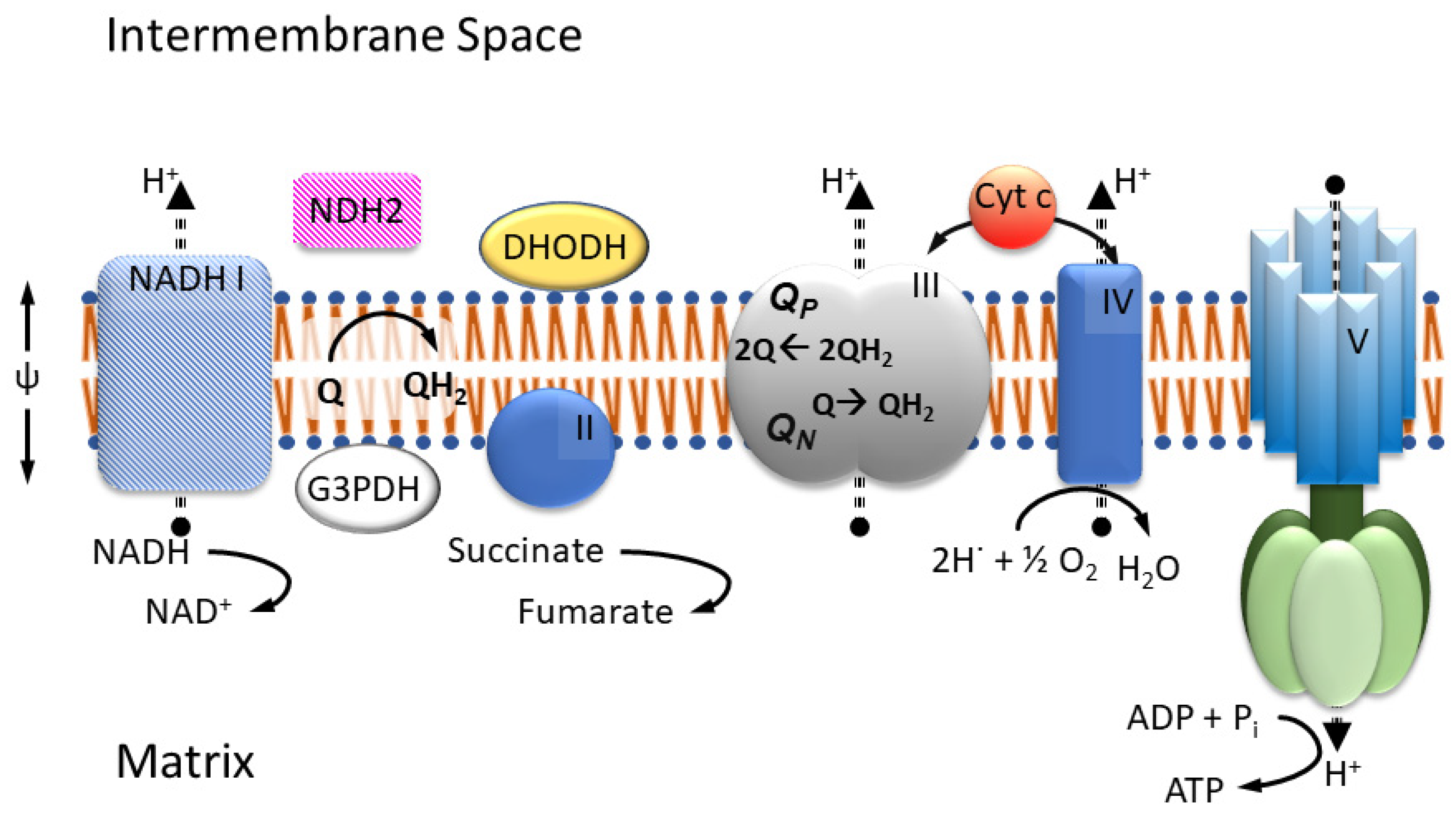
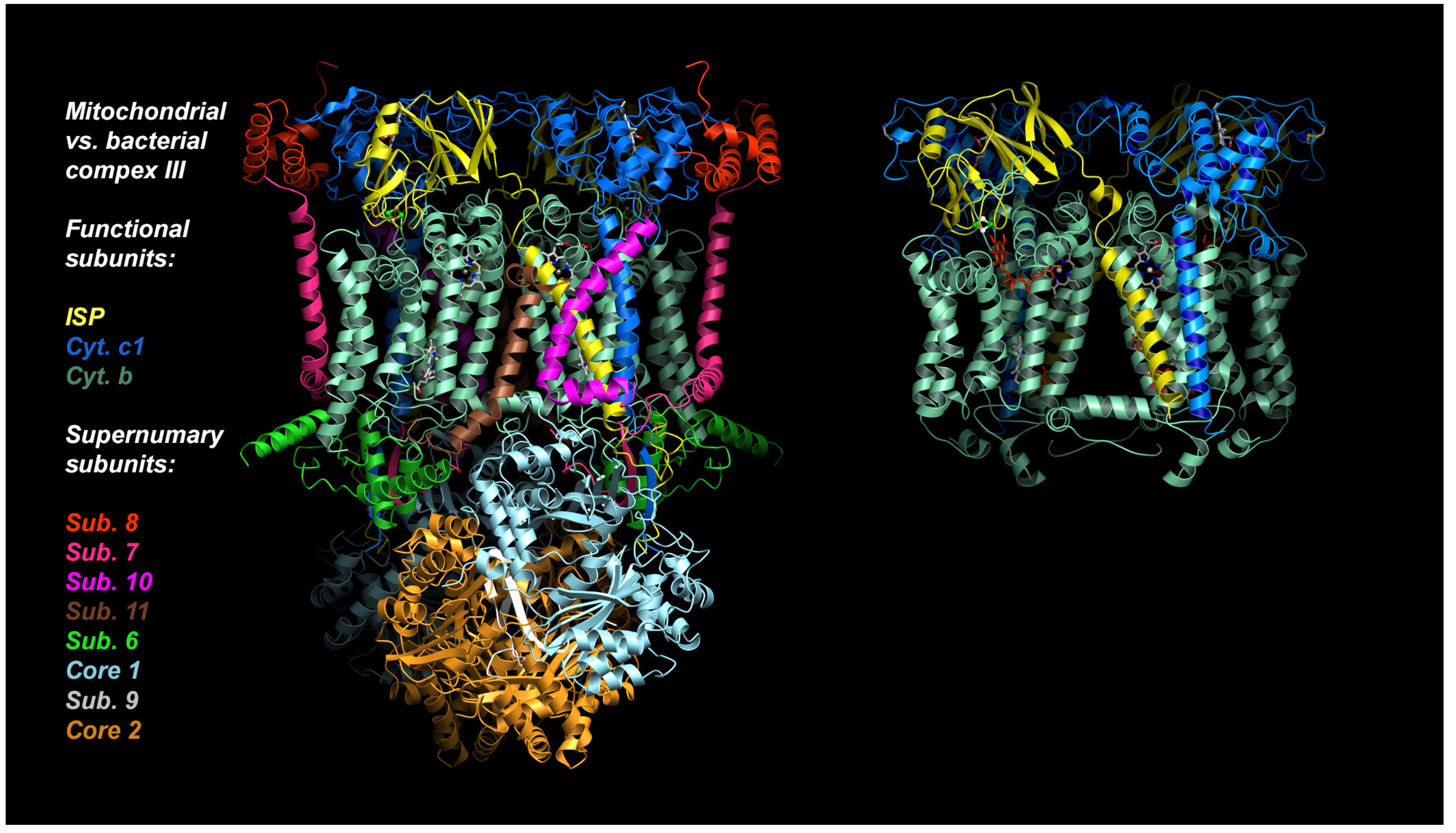


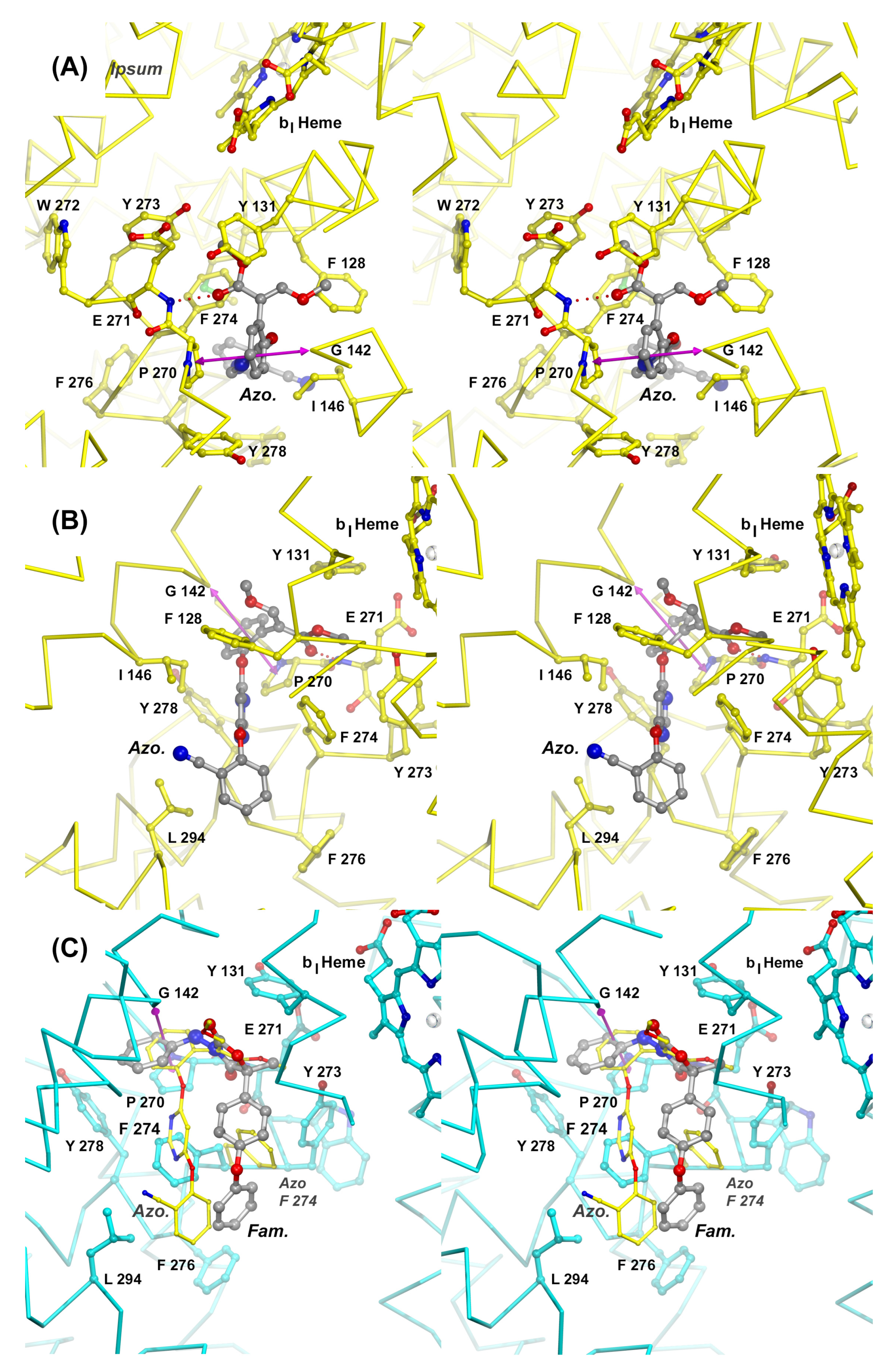
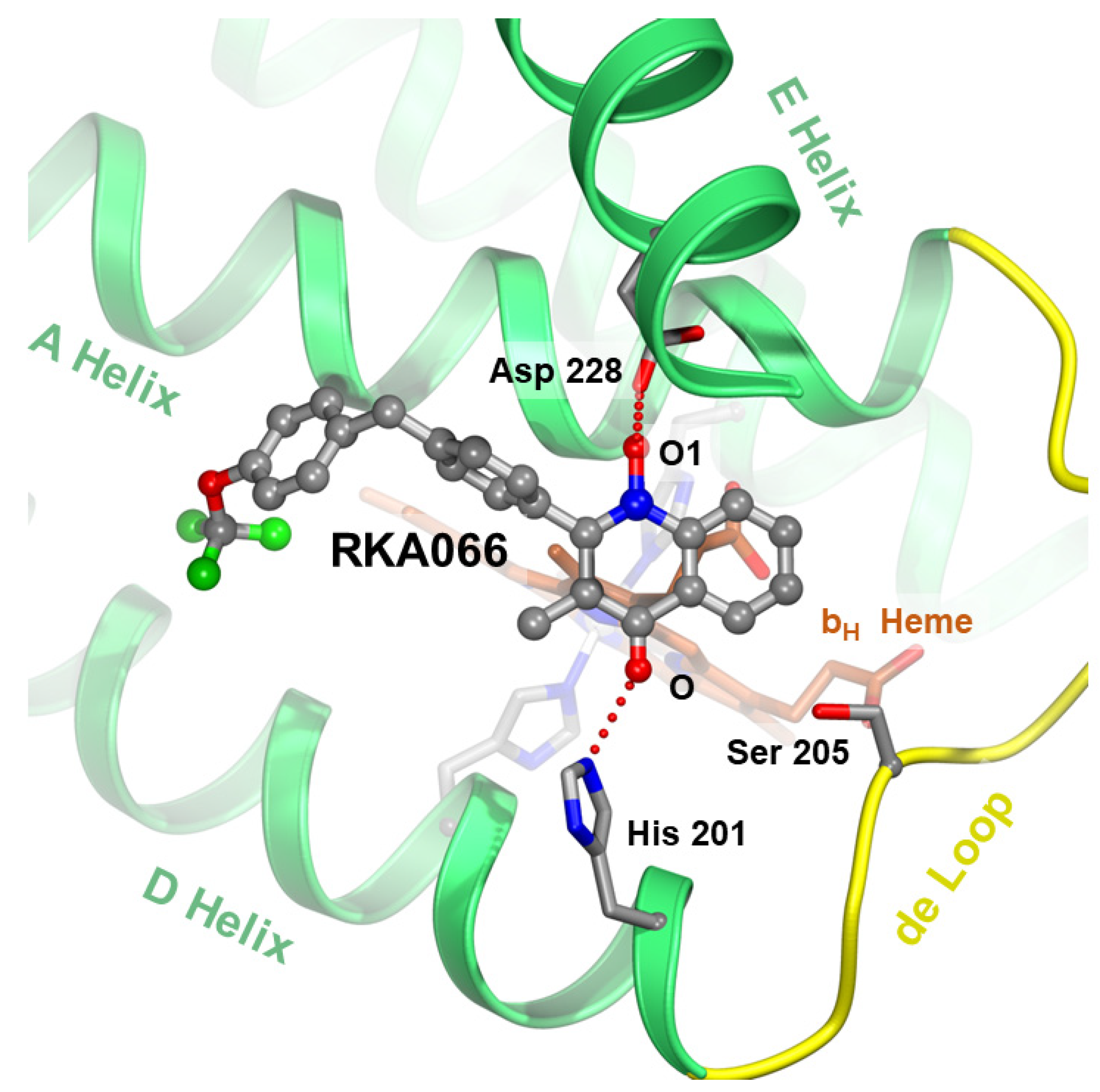


Disclaimer/Publisher’s Note: The statements, opinions and data contained in all publications are solely those of the individual author(s) and contributor(s) and not of MDPI and/or the editor(s). MDPI and/or the editor(s) disclaim responsibility for any injury to people or property resulting from any ideas, methods, instructions or products referred to in the content. |
© 2024 by the authors. Licensee MDPI, Basel, Switzerland. This article is an open access article distributed under the terms and conditions of the Creative Commons Attribution (CC BY) license (https://creativecommons.org/licenses/by/4.0/).
Share and Cite
Esser, L.; Xia, D. Mitochondrial Cytochrome bc1 Complex as Validated Drug Target: A Structural Perspective. Trop. Med. Infect. Dis. 2024, 9, 39. https://doi.org/10.3390/tropicalmed9020039
Esser L, Xia D. Mitochondrial Cytochrome bc1 Complex as Validated Drug Target: A Structural Perspective. Tropical Medicine and Infectious Disease. 2024; 9(2):39. https://doi.org/10.3390/tropicalmed9020039
Chicago/Turabian StyleEsser, Lothar, and Di Xia. 2024. "Mitochondrial Cytochrome bc1 Complex as Validated Drug Target: A Structural Perspective" Tropical Medicine and Infectious Disease 9, no. 2: 39. https://doi.org/10.3390/tropicalmed9020039
APA StyleEsser, L., & Xia, D. (2024). Mitochondrial Cytochrome bc1 Complex as Validated Drug Target: A Structural Perspective. Tropical Medicine and Infectious Disease, 9(2), 39. https://doi.org/10.3390/tropicalmed9020039





